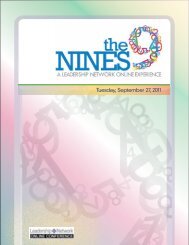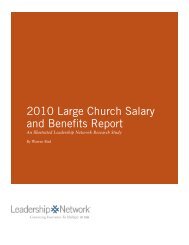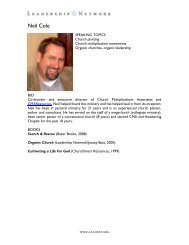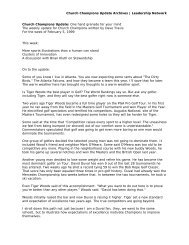ARE WE A PEOPLE AT HALF TIME? - Leadership Network
ARE WE A PEOPLE AT HALF TIME? - Leadership Network
ARE WE A PEOPLE AT HALF TIME? - Leadership Network
You also want an ePaper? Increase the reach of your titles
YUMPU automatically turns print PDFs into web optimized ePapers that Google loves.
World View / Perspective<br />
Nature of Truth<br />
Nature of Faith<br />
Relating the Gospel<br />
Worship Structure<br />
Worship Music<br />
Architecture<br />
D<strong>AT</strong>E<br />
COMMUNIC<strong>AT</strong>ION MODE<br />
CHURCH TRADITION<br />
LITURGICAL<br />
ORAL<br />
4000 BC - 1500 AD<br />
DIALECTIC: An open-ended point/counterpoint<br />
“dialogue" that creates the context for continual<br />
discovery. The auditory character of dialogue creates an<br />
intimate, connected relationship to the universe.<br />
REL<strong>AT</strong>IONAL: Understanding and truth are inherently<br />
connected with the speaker. The message and messenger<br />
cannot be separated.<br />
TRUST: Faith is not a concept but a personal promise and<br />
faith's substance is found in the credibility of the one making<br />
the promise. The Hebrew word for “believe" actually<br />
communicates complete reliance upon what was spoken.<br />
RE-ENACTMENT: A symbolic re-enactment of the<br />
Gospel becomes a mystical drama and connection to<br />
Christ, creating sacred time and sacred place.<br />
LITURGY: A ceremony centered on ritual, symbols and<br />
the common “mystical" experience of the Eucharist.<br />
CHANT: Simple songs originally sung around<br />
scriptures, creating a mystical quality where the position<br />
of the notes held significance and augmented the<br />
content.<br />
ORN<strong>AT</strong>E / FOREGROUND: A physical expression of<br />
the heavenly realm — a sacred place.<br />
REFORMED<br />
PRINT<br />
1500 AD - 1950 AD<br />
CELEBR<strong>AT</strong>ION<br />
BROADCAST<br />
1950 AD - 2000 AD<br />
LOGIC: Writing's sequential structure and linear<br />
progression provides the foundation for rational logic.<br />
The visual character of print creates a detached,<br />
discriminating relationship to the universe.<br />
REL<strong>AT</strong>IVISM: Reasoning has shifted away from “either/or”<br />
conclusions. It has become more important to understand<br />
how one arrives at the conclusion (the process) than the<br />
conclusion itself. The experiential character of broadcast media<br />
creates a subjective existential relationship to the universe.<br />
PRINCIPLE: Truth is abstracted from its source and is<br />
embodied in its content. Truth and revelation produce<br />
intellectual conclusions, which instruct and discipline<br />
the human will (heart).<br />
EXISTENTIAL: Truth is a process that has to be<br />
personally validated, no longer gaining its authority<br />
based on the credibility of an outside source or in the<br />
substance of its content.<br />
BELIEF: Faith is experienced as a concept with content<br />
as opposed to a relationship. The content of faith creates<br />
a moral structure providing discipline to the soul.<br />
CONVICTION: Faith becomes a point of tangibility, a<br />
verifiable moment between the person and God.<br />
RE-TELLING: A logical presentation of historical<br />
evidence and biblical texts, word studies in scripture to<br />
validate the Gospel story.<br />
PERFORMANCE: A celebration of faith — drama,<br />
personal testimony, preaching — to help you sense the<br />
relevance of the message. The intent is to make the<br />
Gospel “hit home" to reach the audience where they live.<br />
SERVICE: A meeting centered on singing “classic"<br />
hymns, confirming doctrinal truth in scripture and<br />
preaching the gospel.<br />
PROGRAM: An event centered on celebration-style<br />
worship, motivational preaching and personal revelation.<br />
HYMN: Complex melodies and harmonies aided by a<br />
printed system of writing music. Hymns communicated<br />
complex truths of the faith.<br />
“I am the Alpha and the Omega,” says the Lord God, “who is and who was and who is to come, the Almighty.”<br />
SONG: Simple content and complex rhythms aided by<br />
amplification and numerous electronic instruments<br />
shape this style of music. Songs express more relational<br />
than doctrinal subject material.<br />
R<strong>AT</strong>IONAL / BACKGROUND: Designed to focus on<br />
the effective preaching of the word. Only primary<br />
symbols are used so there is no distraction from the<br />
purpose of the building.<br />
Rev. 1:8 (NASB)<br />
PROMOTIONAL / CENTER STAGE: Designed as<br />
theater to provide full view of the participants. The<br />
space creates an audience/performer relationship.<br />
© Rex Miller<br />
The Millennial Matrix<br />
INCLUSIVE<br />
INTERACTIVE<br />
2000 AD - FUTURE<br />
SYSTEMS THINKING: New assumptions describe<br />
reality as complex and interconnected. The fluid nature<br />
of interactive media reflects a reality requiring the ability<br />
to deal with variable events governed by overarching<br />
system patterns.<br />
ARCHETYPAL: There is a neutral or skeptical outlook<br />
toward the content of truth in favor of finding a larger<br />
context. Themes of truth work better than formulas in<br />
a complex, rapidly changing, interconnected universe.<br />
FAITHFUL SKEPTICISM: Faith will be experienced as a<br />
many-layered journey. There will be great faith in the<br />
medium. Certainty of faith will be viewed as naïve or<br />
dishonest, while struggling with faith will be seen as a deeper<br />
expression of faith — “Lord I believe, help my unbelief."<br />
SIMUL<strong>AT</strong>ION: Multiple venues and a variety of media<br />
will be used like a prism to refract the truth of the Gospel<br />
into a wide spectrum of insight. A single-point message<br />
will be illustrated seven ways for 20 minutes.<br />
G<strong>AT</strong>HERING: Designed to be an interactive<br />
collaboration without preconceived outcomes.<br />
FUSION: A blend of musical forms. There will also be<br />
simpler services with “unplugged" acoustical worship<br />
balancing highly technical productions. Worship will<br />
move from audience participation to audience<br />
collaboration in a stimulating and intimate experience.<br />
BARRIER-FREE / BACKDROP: Effective buildings will<br />
have an open-ended nature, facilitating and encouraging<br />
change. They will be content-rich and provide a multisensorial<br />
experience.<br />
MEDIEVAL<br />
• Manuscript/Oral Communication<br />
• 312 Constantine — unites Rome, converts to Christianity<br />
• 400 St. Augustine — mystic/theologian<br />
St. Augustine<br />
M ystica l<br />
Martin<br />
Luther<br />
MODERN<br />
• 1452 Printing Press — transforms communication<br />
• 1492 Columbus — discovery of the New World<br />
• 1517 Luther — 95 Theses, Protestant Reformation<br />
• 1564 Galileo — origins of modern science and mathematics<br />
• 1611 King James Version — God is object to study<br />
• 1644 Descartes — “Cogito ergo sum” (I think therefore I am)<br />
Empirical<br />
Hierarchy of<br />
Needs<br />
END OF MODERNITY<br />
• Broadcast — transforms communication<br />
• 1872 Darwin — man explains his origin<br />
• 1927 Freud — “man creates God”<br />
• 1954 Maslow — Hierarchy of Needs<br />
• Radical Individualism — Consumerism<br />
Internet<br />
POSTMODERN<br />
• Internet — transforms communication<br />
• Nietzsche — Nihilism (loss of meaning)<br />
• Derrida — Deconstructionism<br />
• Popular Culture — media influences,<br />
Contact, The Sixth Sense, Touched by An Angel,<br />
The Celestine Prophecy, Oprah’s Spirit Moment<br />
Enlightened Mysticism<br />
© Brad Cecil, Ministry Transition Timeline<br />
LEADERSHIP<br />
N E T W O R K • 800-765-5323 • www.leadnet.org







